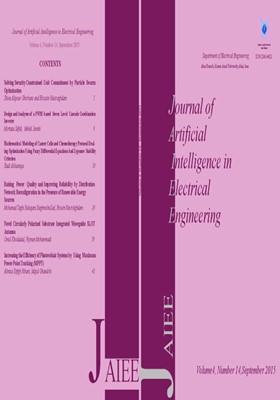Mathematical Modeling of Cancer Cells and Chemotherapy Protocol Dealing Optimization Using Fuzzy Differential Equations And Lypunov Stability Criterion
محورهای موضوعی : journal of Artificial Intelligence in Electrical Engineering
1 -
کلید واژه: The optimal treatment protocol, Mathematical modeling of cancer, fuzzy differential equations, Lyapunov stability criteria,
چکیده مقاله :
Mathematical models can simulate the growth and proliferation of cells in the interaction with healthy cells, the immune system and measure the toxicity of drug and its effects on healthy tissue pay. One of the main goals of modeling the structure and growth of cancer cells is to find a control model suitable for administration among patients. In this study, a new mathematical model is designed to describe the changes in different phases of the cycle T cell proliferation, the population of immune cells, the proposed concentration of drug toxicity and treatment using differential equation and fuzzy Lyapunov stability, an optimal treatment protocol. One feature to consider is the rate of clearance of the drug in the body.
[1] Eisen, M.M,(1979). Mathematical Models in Cell Biology and Cancer Chemotherapy. Volume 30 of Lecture Notes in Biomathematics, Springer-Verlag, New York.
[2] Knolle, H. (1988). Cell Kinetic Modeling and the Chemotherapy of Cancer”, Volume 75 of Lecture Notes in Biomathematics, SpringerVerlag, New York.
[3] Swierniak A., Kimmel M., Smieja J. (2009). Mathematical modeling as a tool for planning anticancer therapy. European Journal of Pharmacology 625, 108–121.
[4] Kimmel, M. and Swierniak, A.(2006).Using control theory to make cancer chemotherapy beneficial from phase dependence and resistant to drug resistance”, J. Math. Biosci.
[5] Ghaffari A., Karimi M. (2009).Optimal Design of Chemotherapy Drug Protocol for Cancer Treatment Based on a New Mathematical Model” Int. J. Modeling, Identification and Control.
[6] Ghaffari A., Nasserifar N. (2009). Mathematical Modeling and Lyapunov based Drug Administration in Cancer Chemotherapy. Iranian Journal of Electronical and Electrical Engineering.
[7] Webb, G.F.(1992). A cell population model of periodic chemotherapy Treatment. In Biomedical Modeling and Simulation, Elsevier Science, .92-83
[8] Kheifetz, Y., Kogan, Y., Agur, Z.,“Long-range predictability in models of cell populations subjected to phase-specific drugs: Growth rate approximation using properties of positive compact operators,” Mathematical Models & Methods in the Applied Sciences. In Press.
[9] Birkhead, B.G., Rakin, E.M., Gallivan, S., Dones, L. and Rubens R.D. (1987). A mathematical model of the development of drug resistance to cancer chemotherapy”, J. Cancer.Clin.Oncol.23(9), 1421-1427.
[10] Swan, G.W. (1987). Tumor growth models and cancer chemotherapy”, In Cancer Modeling, Volume 83, Chapter 3, (Edited by J.R. Thompson and B. Brown), Marcel Dekker, New York, 91-179.
[11] Kirschner, D., Panetta, J. (1998). Modeling immunotherapy of the tumor immune interaction. J. Math. Biol. 37, 235-252.
[12] Villasana, M. (2001). A delay differential equation model for tumor Growth. PhD thesis, Mathematical Department, Claremont University,CA, USA.
[13] Kozusko, F. et al. (2001). A mathematical model of invitro cancer cell growth and treatment with the antimitoic agent curacin A,” Math.Biosci.170, 1-16.
[14] T. Burden, J. Ernstberger and K. Renee Fister (2004). Optimal control applied to immunotherapy”, Discrete and continuous dynamical systems-series B Vol 4.
[15] K.R. Fister and J.H. Donnelly (2005). Immunotherapy: an optimal control theory approach. Mathematical Bioscience and engineering Vol 2.
[16] Liu, W., Hillen, T., Freedman, H., I. (2007). A Mathematical Model for M-PHASE Specific Chemotherapy Including the G0-PHASE and Immune response, J. of MATHEMATICAL BIOSCIENCES AND ENGINEERING Volume 4, Number 2. [17] Mackey, M.C. (2001). Cell kinetic status of hematopoietic stem cells. Cell Prolif., 34, 71-83. [18] Kuznetsov, A., et al. (1994). Nonlinear dynamics of immunogenic tumors: Parameter estimation and global bifurcation analysis”, B. Math. Biol,. .321-295 ,56 [19] Jankovic, M. (1999). Control LyapunovRazumikhin functions for time delay systems. Proceedings of CDC, Phoenix, AZ. [20] Jankovic, M. (2000). Extention of control lyapunov functions to time delay systems. Proceedings of the 39’ IEEE Conference on Decision and Control, Sydney, Australia. [21] Slotine, J.J.E., Li, W.(1991). Applied Nonlinear Control, Prentice Hall International, Englewood Cliffs pp. 58-65. [22] Nikdel, Parisa, et al. "Improved Takagi–Sugeno fuzzy model-based control of flexible joint robot via Hybrid-Taguchi genetic algorithm." Engineering Applications of Artificial Intelligence 33 (2014): 12-20. [23] Pourmahmood, Mohammad, Mohammd Esmaeel Akbari, and Amin Mohammadpour. "An efficient modified shuffled frog leaping optimization algorithm." Int. J. Comput. Appl 32.1 (2011): 0975-8887.


